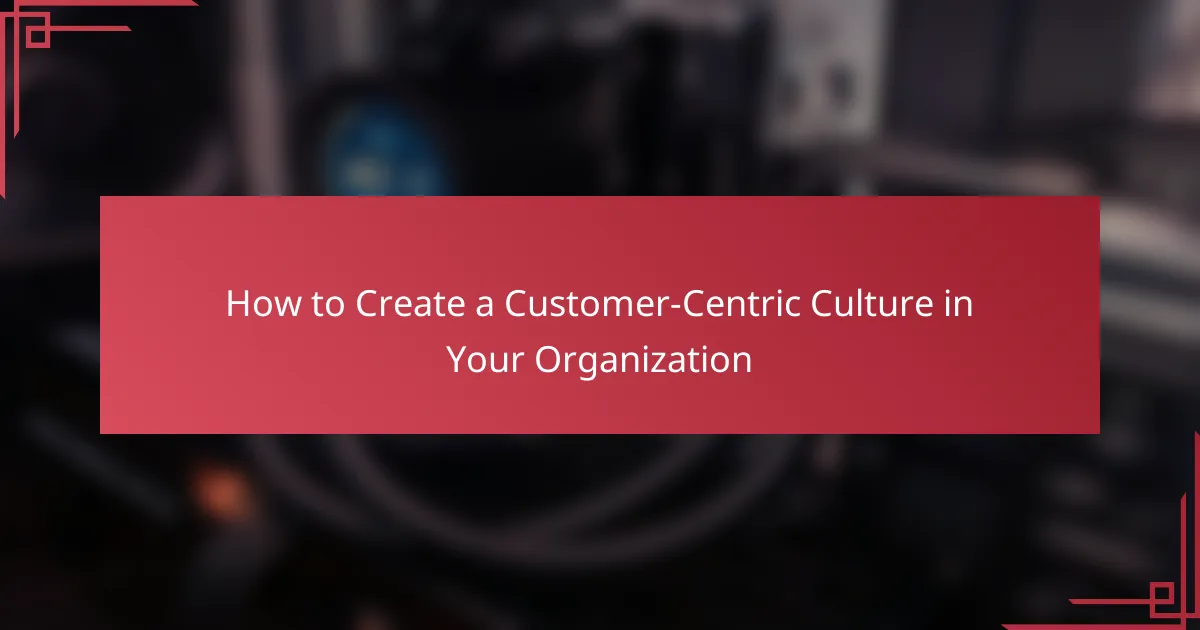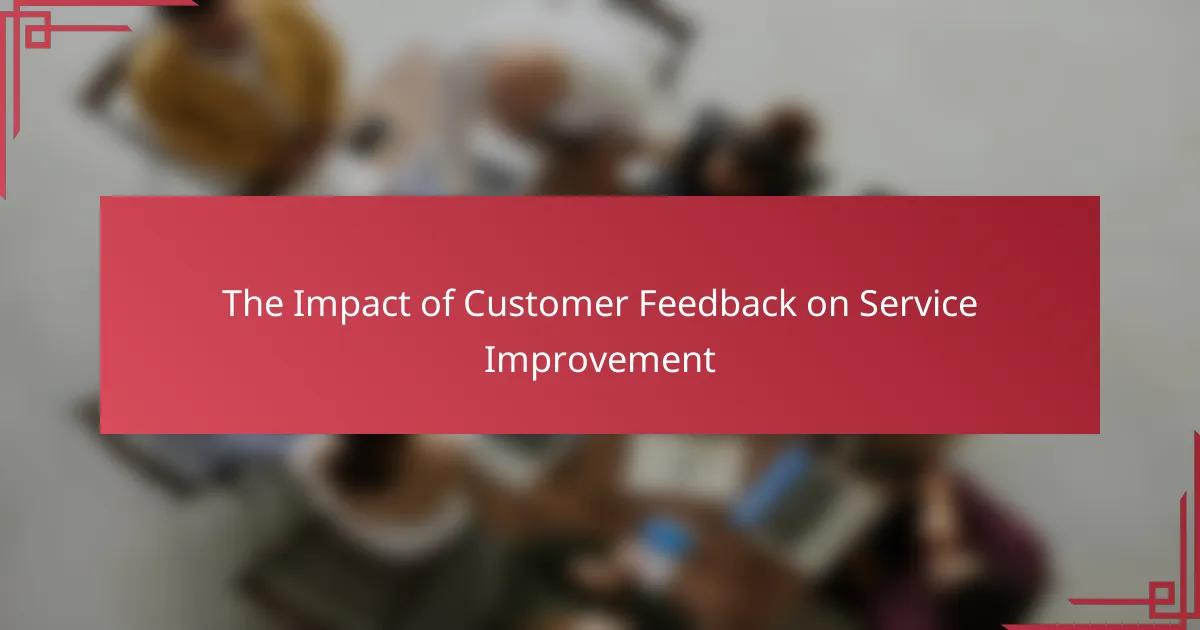Measuring customer engagement metrics is essential for businesses looking to enhance their understanding of customer behavior and improve their strategies. By utilizing analytical tools to track key metrics such as Net Promoter Score (NPS), Customer Satisfaction Score (CSAT), and Customer Lifetime Value (CLV), companies can gain valuable insights into customer loyalty and satisfaction. This data-driven approach enables businesses to refine their engagement efforts and foster stronger relationships with their customers.

How can businesses in the UK measure customer engagement metrics?
Businesses in the UK can measure customer engagement metrics by utilizing various analytical tools and techniques that provide insights into customer behavior and interaction. Effective measurement involves tracking website performance, social media interactions, and direct customer feedback to understand engagement levels and improve strategies.
Utilizing Google Analytics for tracking
Google Analytics is a powerful tool that allows businesses to track website engagement metrics such as page views, session duration, and bounce rates. By setting up goals and events, companies can measure specific actions, like form submissions or product purchases, which indicate customer engagement.
To maximize its effectiveness, businesses should regularly review their analytics dashboard and focus on metrics that align with their goals. For instance, a high session duration may indicate strong engagement, while a high bounce rate could signal a need for content improvement.
Implementing social media analytics tools
Social media analytics tools help businesses track engagement metrics across platforms like Facebook, Twitter, and Instagram. Key metrics include likes, shares, comments, and follower growth, which provide insights into how well content resonates with the audience.
Using tools like Hootsuite or Sprout Social, businesses can analyze trends over time and adjust their social media strategies accordingly. Regularly monitoring these metrics allows companies to identify which types of content drive the most engagement and refine their approach.
Leveraging customer feedback surveys
Customer feedback surveys are essential for gathering direct insights into customer satisfaction and engagement. Surveys can be distributed via email, website pop-ups, or social media, and should focus on specific aspects of the customer experience.
To enhance response rates, keep surveys concise and offer incentives, such as discounts or entry into a prize draw. Analyzing survey results can reveal areas for improvement and help businesses tailor their offerings to better meet customer needs, ultimately boosting engagement.
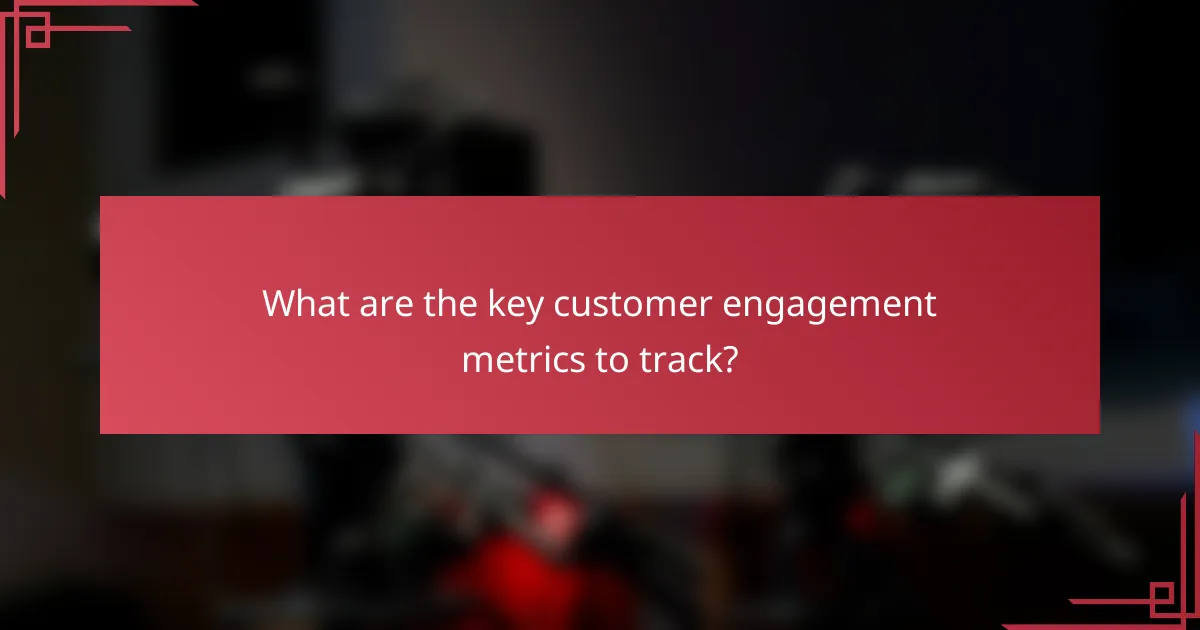
What are the key customer engagement metrics to track?
Key customer engagement metrics include Net Promoter Score (NPS), Customer Satisfaction Score (CSAT), and Customer Lifetime Value (CLV). Tracking these metrics helps businesses understand customer loyalty, satisfaction, and the overall value of their customer relationships.
Net Promoter Score (NPS)
Net Promoter Score (NPS) measures customer loyalty by asking how likely customers are to recommend your product or service to others on a scale from 0 to 10. Customers are categorized into promoters, passives, and detractors based on their scores, allowing businesses to gauge overall sentiment.
A high NPS indicates strong customer loyalty, while a low score suggests areas for improvement. Regularly surveying customers can help track changes in NPS over time and identify trends related to specific products or services.
Customer Satisfaction Score (CSAT)
Customer Satisfaction Score (CSAT) assesses how satisfied customers are with a specific interaction or overall experience. Typically measured through a simple survey question, customers rate their satisfaction on a scale from 1 to 5 or 1 to 10.
To effectively use CSAT, aim for a target score above 80% satisfaction. Regularly collecting this feedback allows businesses to make timely adjustments to improve customer experiences and address any issues promptly.
Customer Lifetime Value (CLV)
Customer Lifetime Value (CLV) estimates the total revenue a business can expect from a customer throughout their relationship. Understanding CLV helps businesses allocate resources effectively and tailor marketing strategies to maximize profitability.
To calculate CLV, consider factors like average purchase value, purchase frequency, and customer lifespan. A common formula is: CLV = (Average Purchase Value x Purchase Frequency) x Customer Lifespan. Monitoring CLV can guide decisions on customer acquisition costs and retention strategies.

How do you analyze customer engagement data?
Analyzing customer engagement data involves examining various metrics to understand how users interact with your brand. Key metrics include website visits, social media interactions, and email open rates, which provide insights into customer behavior and preferences.
Using data visualization tools like Tableau
Data visualization tools such as Tableau help transform complex engagement data into intuitive visual formats. By utilizing dashboards, you can easily track metrics like customer retention rates and conversion funnels, allowing for quick identification of trends and anomalies.
To effectively use Tableau, start by connecting it to your data sources, such as CRM systems or web analytics platforms. Create visualizations that highlight key performance indicators (KPIs) relevant to customer engagement, and ensure they are updated regularly for real-time insights.
Conducting cohort analysis
Cohort analysis involves segmenting customers into groups based on shared characteristics or behaviors over time. This method allows you to evaluate how different cohorts engage with your brand, helping to identify patterns and the impact of specific marketing strategies.
When conducting cohort analysis, consider factors such as the acquisition channel, purchase date, or product usage. For instance, you might compare the engagement levels of customers who joined in different quarters to assess the effectiveness of seasonal campaigns.
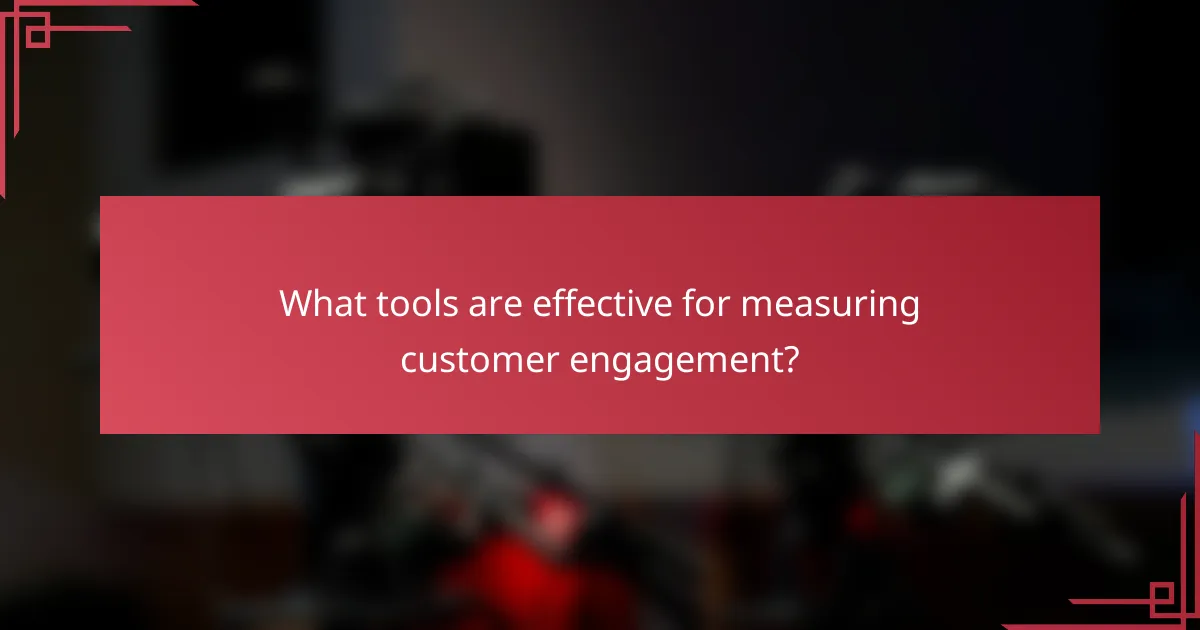
What tools are effective for measuring customer engagement?
Effective tools for measuring customer engagement include CRM analytics, social media metrics, and website user engagement platforms. These tools help businesses track interactions, analyze behavior, and optimize strategies to enhance customer relationships.
HubSpot for CRM analytics
HubSpot offers comprehensive CRM analytics that allow businesses to track customer interactions across various touchpoints. It provides insights into customer behavior, sales performance, and marketing effectiveness, enabling teams to make data-driven decisions.
Key features include customizable dashboards, reporting tools, and integration with other marketing platforms. Businesses can monitor metrics such as lead conversion rates and customer retention, which are crucial for understanding engagement levels.
Sprout Social for social media metrics
Sprout Social specializes in social media metrics, providing detailed analytics on audience engagement across different platforms. It helps businesses measure likes, shares, comments, and overall reach to evaluate their social media performance.
With features like sentiment analysis and competitor benchmarking, Sprout Social enables brands to refine their social strategies. Regularly reviewing these metrics can help identify trends and optimize content for better engagement.
Hotjar for website user engagement
Hotjar focuses on website user engagement by offering tools like heatmaps and session recordings. These features allow businesses to visualize how users interact with their websites, highlighting areas for improvement.
By analyzing user behavior, companies can identify friction points and optimize user experience. Regularly assessing these insights can lead to increased engagement and conversion rates, making it a valuable tool for any online business.
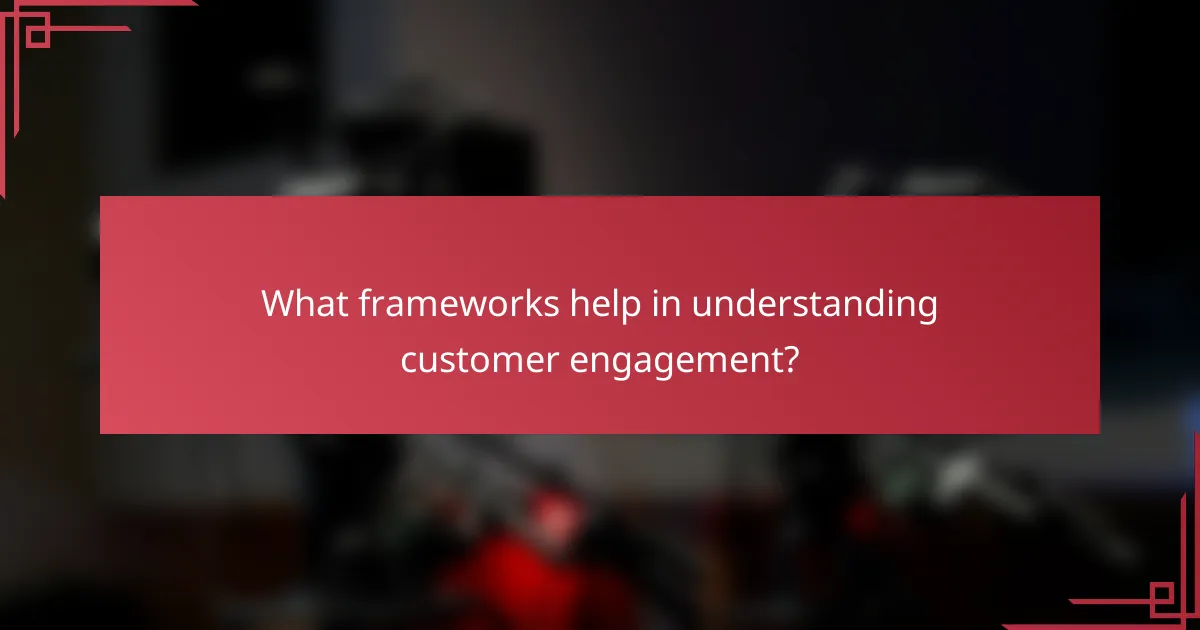
What frameworks help in understanding customer engagement?
Several frameworks can effectively enhance the understanding of customer engagement by providing structured approaches to analyze interactions. These frameworks help businesses identify touchpoints and optimize strategies to improve customer experiences.
Customer Journey Mapping
Customer journey mapping is a visual representation of the customer’s interactions with a brand throughout their lifecycle. This framework allows businesses to identify key touchpoints, understand customer emotions, and pinpoint areas for improvement.
To create an effective customer journey map, gather data from various sources such as surveys, interviews, and analytics. Focus on stages like awareness, consideration, purchase, and post-purchase to capture a comprehensive view of customer experiences.
RACE Framework for digital marketing
The RACE framework stands for Reach, Act, Convert, and Engage, and it provides a structured approach to digital marketing that enhances customer engagement. Each stage focuses on different aspects of the customer journey, helping businesses optimize their marketing efforts.
In the Reach phase, businesses aim to attract potential customers through various channels. The Act phase encourages interactions, such as website visits or social media engagement. Convert focuses on turning prospects into customers, while Engage emphasizes building long-term relationships through ongoing communication and support.

How can customer engagement metrics inform marketing strategies?
Customer engagement metrics provide insights into how effectively your marketing strategies resonate with your audience. By analyzing these metrics, businesses can refine their approaches to better meet customer needs and preferences, ultimately driving higher conversion rates.
Tailoring content based on engagement data
Using engagement data allows marketers to create content that aligns with customer interests and behaviors. For instance, if analytics show high interaction rates with video content, businesses might prioritize video production over other formats. This targeted approach can lead to increased customer satisfaction and loyalty.
Consider segmenting your audience based on engagement levels. Tailor content specifically for high-engagement users, while also developing strategies to re-engage those with lower interaction rates. This ensures that all customer segments receive relevant and appealing content.
Adjusting ad spend based on customer interaction
Customer interaction metrics can guide how much to invest in various advertising channels. If a particular platform shows a strong return on investment (ROI) through high engagement, it may warrant increased ad spend. Conversely, channels with low interaction rates might require reevaluation or reduced budgets.
Establish a regular review process for your ad performance metrics. Set thresholds for engagement that trigger budget adjustments, ensuring that funds are allocated efficiently. For example, if a campaign achieves engagement rates above a certain percentage, consider increasing the budget by a specific percentage to capitalize on the momentum.
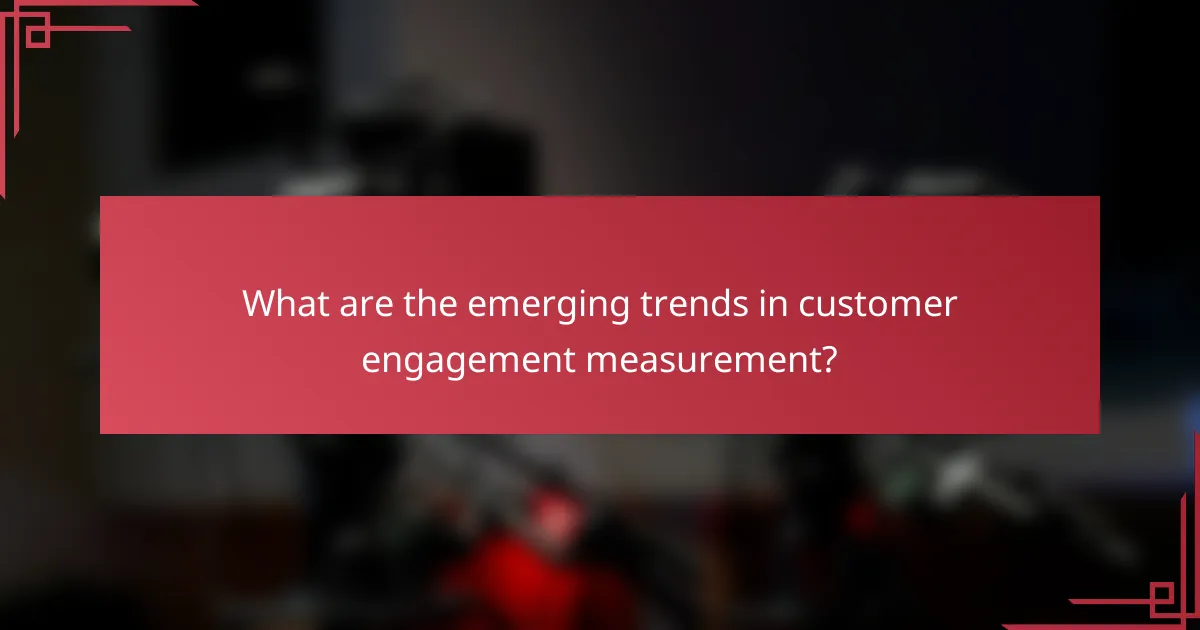
What are the emerging trends in customer engagement measurement?
Emerging trends in customer engagement measurement focus on leveraging advanced analytics, real-time data, and personalized experiences. Businesses are increasingly adopting multi-channel strategies to capture engagement across various platforms, enhancing their ability to understand customer behavior and preferences.
Utilizing AI and Machine Learning
AI and machine learning are revolutionizing customer engagement measurement by providing deeper insights into customer behavior. These technologies analyze vast amounts of data to identify patterns and predict future interactions, allowing businesses to tailor their strategies effectively.
For instance, AI can segment customers based on engagement levels, enabling targeted marketing efforts. Companies can use these insights to adjust their messaging and offers, improving overall engagement rates.
Real-Time Analytics
Real-time analytics is becoming essential for measuring customer engagement effectively. By monitoring customer interactions as they happen, businesses can quickly adapt their strategies to enhance user experiences.
Tools that provide real-time data allow companies to track metrics like page views, click-through rates, and social media interactions instantly. This immediate feedback loop helps identify successful tactics and areas needing improvement.
Personalization Strategies
Personalization is a key trend in customer engagement, as consumers increasingly expect tailored experiences. Businesses are using data-driven insights to customize content, recommendations, and communications based on individual preferences.
Effective personalization can significantly boost engagement metrics. For example, personalized email campaigns often see higher open and click rates compared to generic messages. Companies should focus on gathering data responsibly to enhance personalization without compromising customer privacy.
Multi-Channel Engagement
Multi-channel engagement involves interacting with customers across various platforms, including social media, email, and websites. This approach allows businesses to reach customers where they are most active, improving overall engagement.
To measure multi-channel engagement effectively, companies should track metrics across all platforms and analyze how they influence each other. For example, a customer might discover a product on social media and make a purchase via email, highlighting the importance of cohesive tracking.


